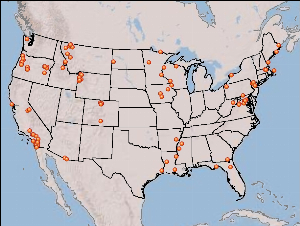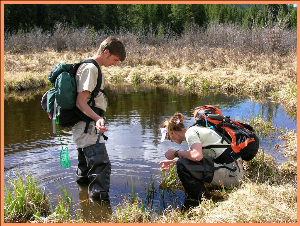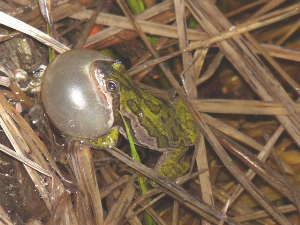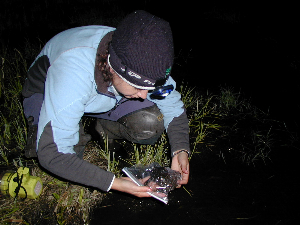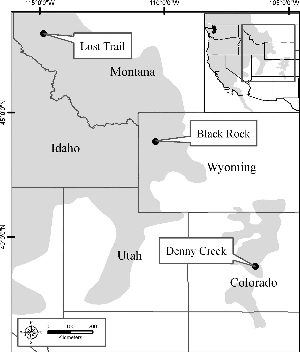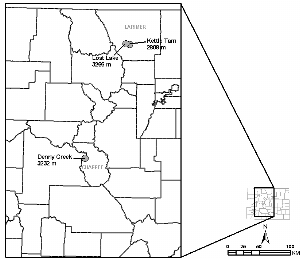Search ARMI Database
Search term(s)
Contribution Number
Search Results
180 record(s) found.
Papers & Reports Factors Influencing Survival and Mark Retention in Postmetamorphic Boreal Chorus
Authors: J E Swanson; Larissa L Bailey; Erin Muths; W C Funk
Date: 2013 | Outlet: Copeia
The ability to track individual animals is crucial in many field studies and often requires applying marks to captured individuals. Toe clipping has historically been a standard marking method for wild amphibian populations, but more recent marking methods include visual implant elastomer and photo identification. Unfortunately, few studies have investigated the influence and effectiveness of marking methods for recently metamorphosed individuals and as a result little is known about this life-history phase for most amphibians. Our focus was to explore survival probabilities and mark retention and migration in postmetamorphic Boreal Chorus Frogs (Psuedacris maculata) in a laboratory setting. Three treatments were assigned randomly among 147 individuals: frogs were either marked with visual implant elastomer, toe clipped, or left unmarked as controls. Growth and mortality were recorded for one year and resulting data were analyzed using known-fate models in Program MARK. Model selection results suggested that survival probabilities of frogs varied with time and showed some variation among marking treatments. We found that frogs with multiple toes clipped on the same foot had lower survival probabilities than individuals in other treatments, but individuals can be marked by clipping a single toe on two different feet without any mark loss or negative survival effects. Individuals treated with visual implant elastomer had a mark migration rate of 4% and mark loss rate of 6% and also showed very little negative survival impacts relative to control individuals.
Papers & Reports The U.S. Geological Survey Amphibian Research and Monitoring Initiative: 2011 Annual Update
Authors: Michael J Adams; Erin Muths; Evan HC Grant; David AW Miller; Hardin J Waddle; Susan C Walls; Lianne Ball
Date: 2012-07 | Outlet: US Geological Survey Fact Sheet 2012-3090
This is the 2011 annual report for the Amphibian Research and Monitoring Initiative. It includes publication updates and a summary of amphibian monitoring trends.
Papers & Reports The Genetic Structure of a relict population of wood frogs
Authors: R D Scherer; Erin Muths; S J Oyler-McCance
Date: 2012-08-18 | Outlet: Conservation Genetics DOI 10.1007/s10592-012-0395-1
Habitat fragmentation and the associated reduction in connectivity between habitat patches are commonly cited causes of genetic differentiation and reduced genetic variation in animal populations. We used eight microsatellite markers to investigate genetic structure and levels of genetic diversity in a relict population of wood frogs (Lithobates sylvatica) in Rocky Mountain National Park, Colorado. We also estimated migration rates among subpopulations, tested for a pattern of isolation-by-distance, and looked for evidence of a recent population bottleneck. The results from the clustering algorithm in Program STRUCTURE indicated the population is partitioned into two genetic clusters (subpopulations), and an estimate of FST (FST = 0.0675, P-value < 0.0001) also supports the genetic differentiation of the two clusters. Migration rates among the two subpopulations were small. Though we found support for a pattern of genetic isolation-by-distance, other processes also may have affected levels of genetic differentiation. Genetic variability in the population is low relative to other studies. However, we found no evidence that a recent bottleneck was responsible for the low variation. Conservation of the population of wood frogs would be improved by increasing the spatial distribution of the population and improving gene flow between the subpopulations. Construction or restoration of wetlands in the landscape between the clusters has the potential to address each of these objectives.
Papers & Reports Effects of hydroperiod duration on survival, developmental rate, and size at metamorphosis in boreal chorus frog tadpoles ( Pseudacris maculata
Authors: Staci M Amburgey; W C Funk; M Murphy; Erin Muths
Outlet: Herpetologica
Understanding the relationship between climate-driven habitat conditions and survival is key to preserving biodiversity in the face of rapid climate change. Hydroperiod—the length of time water is in a wetland—is a critical limiting habitat variable for amphibians as larvae must metamorphose before ponds dry. Changes in precipitation and temperature patterns are affecting hydroperiod globally, but the impact of these changes on amphibian persistence is poorly understood. We studied Boreal Chorus Frog (Pseudacris maculata) tadpole response to simulated hydroperiods (i.e. water level reductions) in the laboratory using individuals collected from ponds spanning a range of natural hydroperiods (Colorado Front Range, USA). To assess the effects of experimental hydroperiod reduction, we measured mortality, time to metamorphosis, and size at metamorphosis. We found that tadpoles grew at rates reflecting the hydroperiods of their native ponds, regardless of experimental treatment. Tadpoles from permanent ponds metamorphosed faster than those from ephemeral ponds across all experimental treatments, a pattern which may represent a predation selection gradient or countergradient variation in developmental rates. Size at metamorphosis did not vary across experimental treatments. Mortality was low overall but varied by pond of origin. Our results suggest that adaptation to local hydroperiod and/or predation and temperature conditions is important in P. maculata. Moreover, the lack of a plastic response to reduced hydroperiods suggests that P. maculata may not be able to metamorphose quickly enough to escape drying ponds. These results have important implications for amphibian persistence in ponds predicted to dry more quickly due to rapid climate change.
Papers & Reports The importance of local and landscape-scale processes to the occupancy of wetlands by breeding wood frogs and boreal chorus frogs
Authors: R D Scherer; Erin Muths; B R Noon
Date: 2012-06-15 | Outlet: Population Ecology 54: 487-498
Variation in the occurrence and abundance of species across landscapes has traditionally been attributed to processes at fine spatial scales (i.e., local conditions), but processes that operate across larger spatial scales such as seasonal migration or dispersal are also important. Recognition of the importance of processes that operate at broad, as well as fine, scales is growing. We evaluated hypothesized relationships between the probability of occupancy in wetlands by wood frogs (Lithobates sylvaticus) and boreal chorus frogs (Pseudacris maculata) during the breeding season and attributes of the landscape measured at three spatial scales in Rocky Mountain National Park, Colorado. We also used cost-based buffers and least-cost distances to derive estimates of landscape attributes at the broader spatial scales represented by seasonal movement and dispersal. Occupancy by breeding wood frogs was associated positively with the amount of streamside habitat adjacent to a wetland and associated negatively with the cost-based distance to the nearest occupied wetland. Occupancy by boreal chorus frogs was associated positively with the number of neighboring, occupied wetlands. We found little evidence that occupancy was correlated with fine-scale attributes measured at the wetlands.
Papers & Reports Portrait of a small population of boreal toads ( Anaxyrus boreas )
Authors: Erin Muths; R Scherer
Date: 2011 | Outlet: Herpetologica
Much attention has been given to the conservation of small populations, those that are small because of decline and those that are naturally small. Small populations are of particular interest because ecological theory suggests that they are vulnerable to the deleterious effects of environmental, demographic, and genetic stochasticity as well as natural and human induced catastrophes. However, testing theory and developing applicable conservation measures for small populations is hampered by sparse data. This lack of information is frequently driven by computational issues with small data sets that can be confounded by the impacts of stressors. We present estimates of demographic parameters from a small population of boreal toads that has been surveyed since 2001 using capture-recapture methods. Estimates of annual adult survival probability are high relative to other boreal toad populations, while estimates of recruitment rate are low. Despite using simple models, clear patterns emerged from the analyses suggesting that population size is constrained by low recruitment of adults and is declining slowly. These patterns provide insights that are useful in developing management directions for this small population and this study serves as an example of the potential for small populations to yield robust and useful information despite sample size constraints.
Papers & Reports Compensatory effects of recruitment and survival when amphibian populations are perturbed by disease
Authors: Erin Muths; R D Scherer; David S Pilliod
Date: 2011 | Outlet: Journal of Applied Ecology
The need to increase our understanding of factors that regulate animal population dynamics has been catalysed by recent, observed declines in wildlife populations worldwide. Reliable estimates of demographic parameters are critical for addressing basic and applied ecological questions and understanding the response of parameters to perturbations (e.g. disease, habitat loss, climate change). However, to fully assess the impact of perturbation on population dynamics, all parameters contributing to the response of the target population must be estimated.
Papers & Reports Breeding chorus indices are weakly related to estimated abundance of boreal chorus frogs
Authors: P. Stephen Corn; Erin Muths; Amanda M Kissel; R D Scherer
Date: 2011-10 | Outlet: Copeia 2011:365-371
Call surveys used to monitor breeding choruses of anuran amphibians generate index values that are frequently used to represent the number of male frogs present, but few studies have quantified this relationship. We compared abundance of male Boreal Chorus Frogs (Pseudacris maculata), estimated using capture-recapture methods in two populations in Colorado, to call index values derived from automated recordings. Single index values, such as might result from large monitoring efforts, were unrelated to population size. A synthetic call saturation index (CSI), the daily proportion of the maximum possible sum of index values derived from multiple recordings, was greater in larger populations, but the relationship was not highly predictive.
Papers & Reports Mitigating amphibian disease: strategies to maintain wild populations
Authors: Douglas C Woodhams; Jaime Bosch; Cheryl J Briggs; S Cashins; L R Davis; A Lauer; Erin Muths; R Puschenforf; Benedikt R Schmidt; B Sheafor; J Voyles
Date: 2011 | Outlet: Frontiers in Zoology
We assess existing disease mitigation strategies, some in early experimental stages, which focus on the globally emerging chytrid fungus Batrachochytrium dendrobatidis with the view that disease mitigation is an essential component of population management. We discuss the precedent for each strategy in systems ranging from agriculture to human medicine, and the outlook for each strategy in terms of research needs and long-term potential.
Papers & Reports The World Congress of Herpetology and Animal Conservation: Excerpts from the 6th World Congress
Authors: T WJ Garner; JM Hero; R Jehle; F Kraus; Erin Muths; R N Reed; R C Vogt; W Hodl
Date: 2010 | Outlet: Animal Conservation 13, Suppl. 1: 1-2
Excepts from the introduction to the published papers arising from the 6th World Congress of Herpetology in Manuas.
Papers & Reports Beyond amphibian declines: Promising directions in understanding the role of disease
Authors: Erin Muths; JM Hero
Date: 2010 | Outlet: Animal Conservation 13, Suppl. 1: 33-35
Introduction (excerpt)to disease symposium publication following the 6th World Congress of Herpetology in Manaus: The goal of the symposium, Amphibian disease: Where do we go from here?, was to foster discussion of “what comes next?” in the efforts of the global scientific community to combat amphibian decline, specifically in the arena of disease. The symposium included presentations from Australia, Denmark, Ecuador, Spain, Kenya and the United States. Topics ranged from laboratory studies to landscape-scale field studies. Although the debate on “what comes next” remains in progress, the symposium prompted discussion and increased international collaborations – including subsequent workshops in Australia and Switzerland. The series of papers from this symposium, featured in this issue, do not provide a roadmap of what comes next, but illustrate the diverse nature of research into amphibian diseases and highlight some of the promising directions being pursued to understand the effects of disease on amphibian populations
Papers & Reports Unbiased Survival Estimates and Evidence for Skipped Breeding Opportunities for a Female Bufonid
Authors: Erin Muths; R Scherer; Brad A Lambert
Date: 2010 | Outlet: Methods in Ecology and Evolution 1: 123-130
1. Estimates of demographic parameters for females, in many organisms, are sparse. This is particularly worrisome as more and more species are faced with high extinction probabilities and conservation increasingly depends on actions dictated by complex predictive models that require accurate estimates of demographic parameters for each sex and species.
2. This study assesses demographic parameters, specifically temporary emigration and survival, for females, a class that has been difficult to investigate historically because of lack of data. Amphibians provide a particularly good example because there is global concern about amphibian decline yet most demographic parameter estimates are based on data from males, which we show can lead to erroneous conclusions.
3. We use 10 years of capture-recapture data from boreal toads (Bufo boreas) and the multi-state open robust design model to provide evidence for the occurrence of skipped breeding opportunities (i.e., temporary emigration) in females. This is the first time that the open robust design model has been applied to an analysis of an amphibian population that we are aware of.
4. We determined that the transition from breeder to non-breeder is obligate and the probability of a non-breeder remaining a non-breeder is 64%, thus temporary emigration is first-order Markovian in nature, where breeding probability is dependent on the previous year’s activity, i.e. if a female did not breed in year one, there is a 36% chance that she will breed in year two. With temporary emigration accounted for, we estimated between-year female survival at 87%.
5. Establishing the occurrence of temporary emigration not only reduces bias in estimates of survival probabilities, but also provides information about expected breeding attempts by females, a critical element in understanding the ecology of an organism and the impacts of outside stressors and conservation actions.
2. This study assesses demographic parameters, specifically temporary emigration and survival, for females, a class that has been difficult to investigate historically because of lack of data. Amphibians provide a particularly good example because there is global concern about amphibian decline yet most demographic parameter estimates are based on data from males, which we show can lead to erroneous conclusions.
3. We use 10 years of capture-recapture data from boreal toads (Bufo boreas) and the multi-state open robust design model to provide evidence for the occurrence of skipped breeding opportunities (i.e., temporary emigration) in females. This is the first time that the open robust design model has been applied to an analysis of an amphibian population that we are aware of.
4. We determined that the transition from breeder to non-breeder is obligate and the probability of a non-breeder remaining a non-breeder is 64%, thus temporary emigration is first-order Markovian in nature, where breeding probability is dependent on the previous year’s activity, i.e. if a female did not breed in year one, there is a 36% chance that she will breed in year two. With temporary emigration accounted for, we estimated between-year female survival at 87%.
5. Establishing the occurrence of temporary emigration not only reduces bias in estimates of survival probabilities, but also provides information about expected breeding attempts by females, a critical element in understanding the ecology of an organism and the impacts of outside stressors and conservation actions.
Papers & Reports How Relevant is Opportunistic Bd Sampling: Are We Ready for the Big Picture?
Authors: Erin Muths; Britt S Pederson; Finn S Pederson
Date: 2009 | Outlet: Herpetological Review 40: 183-184
Understanding the distribution of chytridiomycosis, both at global and local scales, is important to controlling its impacts on host species (e.g., biocontrol or eradication) and to managing host amphibian populations (e.g., reintroduction and habitat management). In response to this, efforts to map observations of Batrachochytrium dendrobatidis (Bd) are underway to better understand its distribution and impact on amphibian populations. (e.g www.spatialepidemiology.net\Bd).
While there are many legitimate reasons to sample opportunistically for this pathogen, we question the validity of continuing this sort of exercise without a more cohesive and directed effort to apply the information to management of Bd. We use a recent example (Scalera et al. 2008) and some additional data from Denmark to discuss this question.
While there are many legitimate reasons to sample opportunistically for this pathogen, we question the validity of continuing this sort of exercise without a more cohesive and directed effort to apply the information to management of Bd. We use a recent example (Scalera et al. 2008) and some additional data from Denmark to discuss this question.
Papers & Reports Long-Term Observations of Boreal Toads at an ARMI Apex Site
Authors: P. Stephen Corn; Erin Muths; David S Pilliod
Date: 2011 | Outlet: The 10th Biennial Scientific Conference on the Greater Yellowstone Ecosystem. Laramie, WY: University of Wyoming, William D. Ruckelshaus Institute of Environment and Natural Resources. In press.
The US Geological Survey’s Amphibian Research and Monitoring Initiative (ARMI) is a national project with goals to monitor the status and trends of amphibians, conduct research on causes of declines, and provide information and support to management agencies for conservation of amphibian populations. ARMI activities are organized around extensive inventories and place-based monitoring (such as collaboration with the Greater Yellowstone I&M Network), and intensive population studies and research at selected locations (apex sites). One such is an oxbow pond on the Buffalo Fork near the Black Rock Ranger Station east of Grand Teton National Park. We have been conducting capture-mark-recapture of boreal toads (Anaxyrus boreas) at Black Rock since 2002. In concert with studies of other toad populations in the Rocky Mountains, we have documented a high rate of incidence of the chytrid fungus Batrachochytrium dendrobatidis (Bd) and a negative rate of growth of the toad population, but not the population crash or extinction observed in other populations with high occurrence of Bd.
Long-term observations at other ARMI apex sites have proven invaluable for studying effects of climate change on amphibian behavior, and the Black Rock site has been upgraded with on-site recording of temperature and precipitation, and auditory monitoring of other amphibian species. Continued research at Black Rock will be critical for understanding the interrelated effects of climate and disease on amphibians in the Greater Yellowstone Ecosystem.
Long-term observations at other ARMI apex sites have proven invaluable for studying effects of climate change on amphibian behavior, and the Black Rock site has been upgraded with on-site recording of temperature and precipitation, and auditory monitoring of other amphibian species. Continued research at Black Rock will be critical for understanding the interrelated effects of climate and disease on amphibians in the Greater Yellowstone Ecosystem.
Papers & Reports An evaluation of weather and disease as causes of decline in two populations of boreal toads
Authors: R D Scherer; Erin Muths; B R Noon; P. Stephen Corn
Date: 2005 | Outlet: Ecological Applications 15: 2150–2160
Two populations of boreal toads (Bufo boreas) experienced drastic declines in abundance in the late-1990s. Evidence supported the hypothesis of disease (the chytrid fungus, Batrachochytrium dendrobatidis) as the cause of these declines, but other hypotheses had not been evaluated. We used an 11- year capture-recapture data set to evaluate weather and disease as causes of these declines. We developed sets of mathematical models that reflected hypothesized relationships between several weather variables and annual survival rates of adult males in these populations. In addition, models that reflected the possibility that the declines were caused by an introduced fungus were developed. All models were fit to the data and evaluated using a model selection criterion (QAICc). Our analysis provided strong support for the hypothesis of an introduced fungus and little support for the hypothesis that weather conditions caused the declines. Our results also suggest a strong, negative ‘marking effect’ on survival rates of boreal toads. Model-averaged estimates of survival rate are presented.
Papers & Reports The effects of weather on survival in populations of boreal toads in Colorado
Authors: R D Scherer; Erin Muths; Brad A Lambert
Date: 2008 | Outlet: Journal of Herpetology 42: 508–517
Understanding the relationships between animal population demography and the abiotic and biotic elements of the environments in which they live is a central objective in population ecology. For example, correlations between weather variables and the probability of survival in populations of temperate zone amphibians may be broadly applicable to several species if such correlations can be validated for multiple situations. This study focuses on the probability of survival and evaluates hypotheses based on 6 weather variables in 3 populations of Boreal Toads (Bufo boreas) from central Colorado over 8 years. In addition to suggesting a relationship between some weather variables and survival probability in Boreal Toad populations, this study uses robust methods and highlights the need for demographic estimates that are precise and have minimal bias. Capture-recapture methods were used to collect the data, and the Cormack-Jolly-Seber model in program MARK was used for analysis. The top models included minimum daily winter air temperature and the sum of the model weights for these models was https://0.956. Weaker support was found for the importance of snow depth and the amount of environmental moisture in winter in modeling survival probability. Minimum daily winter air temperature was positively correlated with the probability of survival in Boreal Toads at other sites in Colorado and has been identified as an important covariate in studies in other parts of the world. If air temperatures are an important component of survival for Boreal Toads or other amphibians, changes in climate may have profound impacts on populations.
Papers & Reports Pseudacris triseriata (western chorus frog) and Rana sylvatica (wood frog) – Chytridiomycosis
Authors: S Rittmann; Erin Muths; David E Green
Date: 2003 | Outlet: Herpetological Review 34: 53
PSEUDACRIS TRISERIATA (Western Chorus Frog) and RANA SYLVATICA (Wood frog). CHYTRIDIOMYCOSIS. Chytrid fungus (Batrachochytrium dendrobatidis) is a known pathogen of anuran amphibians, and has been correlated with amphibian die-offs worldwide (Daszak et. al. 1999. Emerging Infectious Diseases 5: 735-748). In Colorado, B. dendrobatidis has infected Boreal toads (Bufo boreas)and has been identified on museum specimens of northern leopard frogs (Rana pipiens) (Carey et. al. 1999. Developmental and Comparative Immunology 23: 459-472). We report the first verified case of chytrid fungus in chorus frogs (Pseudacris triseriata) and wood frogs (Rana sylvatica) in the United States.
Papers & Reports Effects of the amphibian chytrid fungus on toad survival
Authors: David S Pilliod; Erin Muths; R D Scherer; Paul E Bartelt; P. Stephen Corn; Blake R Hossack; Brad A Lambert; Rebecca M McCaffery; C Gaughan
Date: 2010 | Outlet: Conservation Biology 24: 1259-1268
Chytridiomycosis is an amphibian disease linked with population declines worldwide, yet there is little information about its effects on the demography of infected populations. We used capture-recapture data from two infected populations and one uninfected population of boreal toads (Bufo boreas) in the Rocky Mountains, U.S.A. to examine a priori hypotheses about the effect of the amphibian chytrid fungus (Batrachochytrium dendrobatidis, Bd) on survival probability (&#934;) and population growth rate (&#61548;). Bd-positive toads had lower average annual &#934; than Bd-negative individuals at sites where Bd was detected suggesting that chytridiomycosis may reduce survival by 31-42% in wild boreal toads. Bd-negative toads at infected sites had comparable survival probabilities as Bd-negative toads at the uninfected site, further supporting observed differences. Model results indicated weak evidence that environmental covariates (particularly cold temperatures during the breeding season) influenced toad survival. The diseased populations were declining by 5 - 7% per year over the 6 years of this study whereas the Bd-free population had comparatively stable (&#61548; &#8776; 1) population growth. Our data suggest that Bd is a low-level chronic mortality factor in these toad populations rather than an acute factor causing rapid population declines. These results show how some amphibian populations may be coexisting with the amphibian chytrid fungus and highlight the importance of quantitative assessments of survival in wildlife populations challenged with disease.
Papers & Reports Designing monitoring programs to assess reintroduction efforts: a critical component in recovery
Authors: Erin Muths; V J Dreitz
Date: 2008 | Outlet: Animal Biodiversity and Conservation 31: 47–56
Reintroduction is a powerful tool in our conservation toolbox. However, the necessary follow-up, i.e. long-term monitoring, is not commonplace and if instituted may lack rigor. We contend that valid monitoring is possible, even with sparse data. We present a means to monitor based on demographic data and a projection model using the Wyoming toad (Bufo baxteri) as an example. Using an iterative process, existing data is built upon gradually such that demographic estimates and subsequent inferences increase in reliability. Reintroduction and defensible monitoring may become increasingly relevant as the outlook for amphibians, especially in tropical regions, continues to deteriorate and emergency collection, captive breeding, and reintroduction become necessary. Rigorous use of appropriate modeling and an adaptive approach can validate the use of reintroduction and substantially increase its value to recovery programs.
Papers & Reports Estimation of the probability of male toads to return to the breeding site
Authors: Erin Muths; R D Scherer; P. Stephen Corn; Brad A Lambert
Date: 2006 | Outlet: Ecology 87: 1048–1056
Male boreal toads are thought to return to the breeding site year after year and, if absent in a particular year, be more likely to be present the following year. Using Pollock’s robust design we estimated temporary emigration (the probability a male toad is absent from a breeding site in a given year) at locations in Colorado: Rocky Mountain National Park (n=2) and Chaffee County (n=1). We present data that suggest that male toads do not return to the breeding site every year. Estimates of both temporary emigration parameters ( ’ = probability that a male toad is absent from the breeding site at time i if absent at time i - 1; ” = probability that a male toad is absent at time i if present at time i - 1) varied by site and time (for example, at Lost Lake, the probability of temporary emigration ranged from 10 - 29%). Although we suspected that the probability of temporary emigration would be state dependent (Markovian temporary emigration, e.g. whether a male toad is at the breeding site at time i is affected by whether it was at the breeding site at time i - 1), the data showed greater support for models of random temporary emigration or no emigration. However, some models of Markovian emigration were supported. We also hypothesized relationships between temporary emigration and a number of environmental variables. While some competitive models included environmental covariates, model selection uncertainty precluded fully defining the role of these covariates in temporary emigration.

